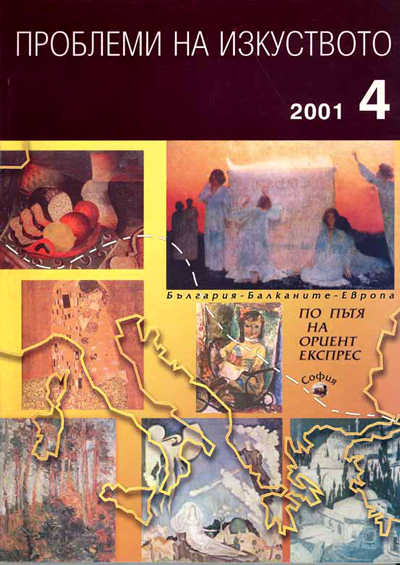Сецесионът в живописта на южните славяни - една от насоките на "Модерната"
The Secession in South-Slavic Painting: a Trend in the Moderna
Author(s): Milena GeorgievaSubject(s): History, Fine Arts / Performing Arts, Cultural history, Visual Arts
Published by: Институт за изследване на изкуствата, Българска академия на науките
Summary/Abstract: The article is a first attempt at a contrastive re search into secession in the South-Slavic countries: Bulgaria, Serbia, Croatia and Slovenia. The work is divided into sub-subjects as follows: history of the trend as implanted in the history of the early modernism in the South-Slavic countries; the symbolic beginnings in South-Slavic secession; between secession and impression ism; the clash between “the native” and “the foreign” as a characteristic feature of South-Slavic secession; .from the idea of symbolic to the stylistic expression of secession. At the end of 19th and the beginning of 20th century secession on the Balkan is for the first time a carrier of not the novelty and modernity only, but a messenger of “rebellion” as well. The most typical early patterns are set in the works of the Croatians: V. Bukovats, B. Chikosh, Ts. Medovich; the Bulgarians: N. Mihailov, H. Tachev, S. Badjov, G. Datsov; the Serbians: M. Mourat and L. Koen, while Serbian and Slovenian oil-painting are in a closer connection to impressionism. Slavic contemplation and softness shut the presence of the horrible, fearsome and grotesque out of South-Slavic secession and lead to a subtle symbolic in oil-painting while keeping to secession stylistic methods. Another characteristic of painting from the South-Slavic Moderna period is the intermingling of secession and impressionism, are in some countries they remain interwoven as late as the end of the 1920s. The re assessment of the national myth as preserved in the epic, folklore and village everyday life manifested namely at the second stage of the Moderna development in Croatia, partially in Serbia, as well as in its Bulgarian equivalent, the period of i.d. Native Art. The epic of Kraly Marko turned. Out to be particularly relevant for interpreting at that period uniting Slavs. The works of the Croatians: M. Rachky, L. Babich, T. Krizman, I. Meshtrovich, and the Bulgarians: I. Milev, I. Penkov, N. Rainov and Sirak Skitnik are quite similar in their aiming at implanting the inventions of universal secession into national mythology, and to use secession style and methods in decorative expression of native (national) suggestion by means of the right subjects and symbolic. Those similarities in the attempts of South-Slavic countries result in the involvement of South-Slavic artists into the orbit of European style, as well as to its enrichment with later original interpretations based on native tradition.
Journal: Проблеми на изкуството
- Issue Year: 2001
- Issue No: 4
- Page Range: 25-31
- Page Count: 7
- Language: Bulgarian
- Content File-PDF

